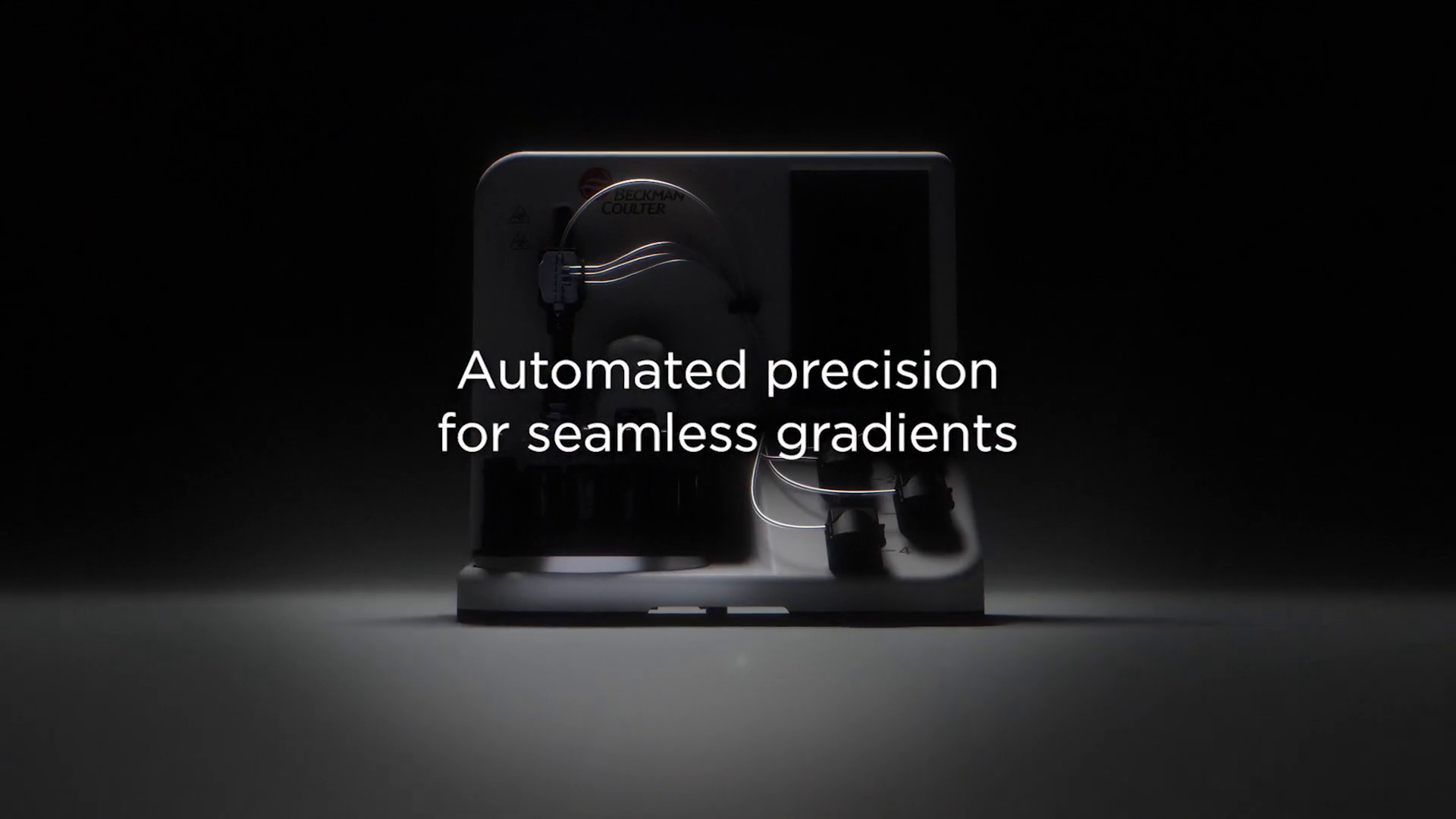OptiMATE Gradient Maker Features
The OptiMATE Gradient Maker simplifies the laborious and error-prone density gradient ultracentrifugation (DGUC) process into an easy-to-maintain operation by automating nearly all pre-centrifuge steps, including gradient preparation, tube sealing, and accurate dispensing, significantly reducing run times without sacrificing purity or yield.
文稿
Hi. I'm Sean. I'm thrilled to introduce you to the latest innovation from Beckman Coulter Life Sciences that promises to revolutionize the way you do purification.
This is the OptiMATE Gradient Maker.
At a high level, the OptiMATE Gradient Maker prepares tubes for density gradient ultracentrifugation.
Density gradients are used for the high resolution purification of viral vectors, extra extracellular vesicles, protein complexes, and more. However, these experiments are historically very laborious and error prone with many manual steps, and the run times are typically overnight.
Let's dive into some of the key features of the OptiMATE system to learn how it can eliminate these challenges to transform your workflow. When we designed this instrument, versatility was a top priority for us because we understand how crucial density gradients are across a variety of different fields, and we wanted to make sure it could meet the needs of as many researchers as possible. The OptiMATE system is composed of several key components, including a touchscreen, peristaltic pumps, a fluidic path, dispense probe, probe guide, seal former, calibration tube, prime tube, and a carousel with racks.
It's compatible with several gradient materials including cesium chloride, iodixanol, and sucrose, which offers you great flexibility as your lab grows and your projects continue to evolve. It can also be used with several different rotors ranging from swinging bucket to vertical rotors and many different tube formats like OptiSeal, Quick-Seal, and Open-Top. This versatility ensures that the instrument can be used for nearly any application.
With its simple user interface, you can create and run methods with just a few clicks, and the instrument walks you through this every step of the way. It also has the ability to dispense both step and linear gradients while incorporating sample and ceiling tubes, allowing you to seamlessly integrate OptiMATE into your already existing protocol. The instrument comes preloaded with standard AAV purification methods for both cesium chloride and iodixanol.
Creating a new method is as simple as selecting the tube type, adjusting the tube sealing settings and number of tubes, selecting reagents, and then defining the gradient profile.
Graphical representations of the tube composition for each gradient method are provided for clear visualization.
Once a method is established, OptiMATE provides step by step instructions for connecting the accessories, priming the fluidic lines, calibrating the pumps, and finally, running the method. Liquid level sensing is utilized to ensure the tubes are filled to the appropriate level for centrifugation.
Once the method is complete, OptiMATE lines can be flushed and cleaned using standard cleaning solutions like isopropyl alcohol and sodium hydroxide, and they can be sterilized and reused.
Drawing on our decades of experience with automated liquid handling solutions, the OptiMATE Gradient Maker was designed with ease of use in mind. By eliminating nearly all of the pre centrifugation steps, variability that arises during manual gradient preparation can be eliminated and reductions in hands on time can be achieved. This ensures that each run is highly reproducible regardless of who's operating the system. Another thing that sets the instrument apart is how it makes density gradient preparation accessible even to novice users.
Becoming proficient in density gradients used to take weeks or even months of rigorous training, but with OptiMATE, new users can begin preparing gradients in just hours without sacrificing accuracy, quality, or purity. One of the most impactful benefits, which is perhaps not immediately intuitive, is that OptiMATE can afford significantly shorter centrifuge run times. Isopycnic separations are known as a gold standard across many particle types because of their high resolution separation. However, these experiments rely on linear gradients and the process is very time consuming, often taking sixteen hours or longer because the gradient only forms under centrifugal force.
By dispensing a preformed linear gradient using the OptiMATE system, run times can be reduced by up to seventy five percent, allowing you to complete the separation in just a single working shift. Whether you're working on AAV or any other application that requires density gradients, OptiMATE can fundamentally transform your workflow by introducing automation, efficiency, and reliability to your gradient preparation. Combined with our Optima X Series Ultra Centrifuges and OptiMATE reagents, you can achieve automated precision for seamless gradients.
相关视频
OptiMATE Gradient Maker
The OptiMATE Gradient Maker simplifies the laborious and error-prone density gradient ultracentrifugation (DGUC) process into an easy-to-maintain operation by automating nearly all pre-centrifuge steps, including gradient preparation, tube sealing, and accurate dispensing, significantly reducing run times without sacrificing purity or yield.


